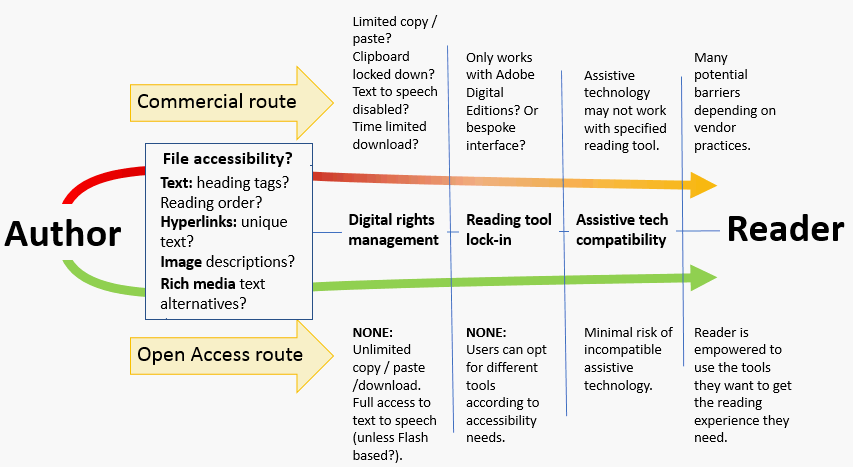It seems tautological to write a blog post on open access and accessibility. Surely if something is open access then it is open to anyone and therefore accessible to anyone?
Alistair McNaught argues that the link between open access and accessibility is more nuanced than you might expect. Authors and institutions need simple guidelines to make open access genuinely accessible to all.
“When I use a word,” Hum pty Dumpty said, in rather a scornful tone, “it means just what I choose it to mean—neither more nor less.” (Through the Looking Glass, Lewis Carroll).
pty Dumpty said, in rather a scornful tone, “it means just what I choose it to mean—neither more nor less.” (Through the Looking Glass, Lewis Carroll).
Humpty Dumpty would have been fond of the word ‘accessibility’. It has different layers of meaning depending on who you are. A search for “Accessibility” on the Jisc website returns nearly 250 blog posts but it’s not until the third page of results that any match the accessibility needs of disabled users. The other articles are about accessibility in all the other senses of the word.
It is easy to forget that, demographically speaking, an estimated 10% of the population have a print impairment – for example dyslexia, visual difficulties or an inability to physically handle books. That equates to 6 million people in the UK, and nearly half a million students in Further and Higher Education.
Open Access publications can significantly support print impaired students by giving them more options.
Option one: reading lists enhanced by OERs.
If core reading depends on commercial offerings, it costs. Institutions can only afford to support a limited number of alternatives but including open access resources makes changes everything. Students can access multiple explanations by different authors, diverse case studies and a wider range of supplementary resources such as images, diagrams and models. These can be more meaningful to students with different learning preferences.
Starting points for enhancing reading lists with open access resources can include
- Textbooks
- Courses
- Journals
Option two: OERs and enhanced personalisation.
There are two key differences between commercial and open access content:
- open access content does not need Digital Rights Management and therefore it can dispense with Technical Protection Measures.
- Secondly, and related to this, open access content does not need to be tied to a particular delivery mechanism like Adobe Digital Editions.
The role of authors in OER accessibility
Irrespective of the route from the author to the reader, the author has a responsibility to make the raw file as accessible as possible. If authors fail to use heading tags (just using visual formatting instead), disabled users cannot use navigation tools to rapidly move through the content. Content with a complex visual layout will need the reading order tagged. Authors are the best people to decide which images best illustrate their arguments and to provide a meaningful text description of the main ‘take-away’ teaching points. Likewise, authors are best placed to provide the text alternatives to any rich media included in the resource.
The role of tutors and study support staff
Many students arriving at university have very limited experience of e-books and journals. They are not aware of the limitations of commercial library systems. Tutors, librarians, study support and disability staff all have a role to play in helping students understand the pros and cons of different resources.
For commercial content the likelihood of barriers is higher. Digital rights management usually restricts copying and pasting. Text-to-speech may be disabled. Downloads may last only 24 hours. The text may be viewable only in an unfamiliar (and poorly accessible) interface with few personalisation options. The chance of assistive technology working may be slim. The reader may experience barriers and need an alternative format provided from the publisher or inhouse.
With no technical protection measures and no requirement to use a particular (and often inaccessible) delivery mechanism, the flow of information in an open educational resource is smoother. Readers can copy, paste and download. They can use within their preferred reading devices and have a high chance of success with assistive technology. The alternative information flows from the author’s head to the reader’s experience is summarised in figure 1 below.

Conclusion
Open educational resources are ideally placed to form an important element of any institutions accessibility policy. Integrate them in reading lists, make students aware of their enhanced accessibility potential and students can have a better experience without any extra cost to the institution.
However, digital accessibility is not automatic. An author needs only modest skills to make the raw file accessible, yet they still need to be learned and consistently applied.
The open access community itself can play a part in changing culture. When good accessibility is as much of a ‘hygiene factor’ as good citation habits, then open access will be properly open..
